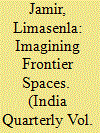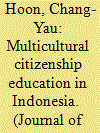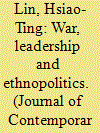| Srl | Item |
| 1 |
ID:
027155


|
|
|
|
|
| Edition |
3rd ed.
|
| Publication |
London, Cassell and Company Ltd., 1972.
|
| Description |
576p.: maps.Hbk
|
| Standard Number |
0304291145
|
|
|
|
|
|
|
|
|
|
|
|
Copies: C:1/I:0,R:0,Q:0
Circulation
| Accession# | Call# | Current Location | Status | Policy | Location |
| 011027 | 940.5425/SLI 011027 | Main | On Shelf | General | |
|
|
|
|
| 2 |
ID:
189548


|
|
|
|
|
| Summary/Abstract |
This article concerns the northeast frontier of British India during the last years of British rule. It explores how the conundrums of the Second World War led to the reconfiguration of the northeast frontier as a strategic space in the empire’s geopolitics. This reconfiguration was pushed by contestation over the frontier spaces by different powers—threatened by the Japanese during the Second World War and, later, the possible post-war reification of Chinese and Tibetan expansionist policy towards India’s northeast frontier and the impending Indian independence. The colonial state’s strategic interest led the frontier officials to reimagine the northeast frontier, whereby the region and its local populations came to be regarded as integral to the preservation of the colonial state’s dominance.
|
|
|
|
|
|
|
|
|
|
|
|
|
|
|
|
| 3 |
ID:
124298


|
|
|
|
|
| Publication |
2013.
|
| Summary/Abstract |
This study investigates how multicultural citizenship education is taught in a Chinese Christian school in Jakarta, where multiculturalism is not a natural experience. Schoolyard ethnographic research was deployed to explore the reality of a 'double minority' - Chinese Christians - and how the citizenship of this marginal group is constructed and contested in national, school, and familial discourses. The article argues that it is necessary for schools to actively implement multicultural citizenship education in order to create a new generation of young adults who are empowered, tolerant, active, participatory citizens of Indonesia. As schools are a microcosm of the nation-state, successful multicultural citizenship education can have real societal implications for it has the potential to render the idealism enshrined in the national motto of 'Unity in Diversity' a lived reality.
|
|
|
|
|
|
|
|
|
|
|
|
|
|
|
|
| 4 |
ID:
086322


|
|
|
|
|
| Publication |
2009.
|
| Summary/Abstract |
This article examines how China's war with Japan served as a crucial factor that shaped modern China's ethnopolitics. It argues that the Japanese invasion of China in 1941-1945 provided the Nationalists with an unprecedented opportunity to push their authority further westward into the Central Asian heartlands. The Nationalists' marching westward as a result of the Japanese invasion also urged them to factor frontier and ethnopolitics into their wartime strategic thinking and institutional reforms. To a great extent, the war and its repercussions caused a redefinition of modern China's border security and defense in both northwestern and southwestern China. The war with Japan turned the Nationalists westward, a new perspective which shifted the power relationship between the Nationalists and China's frontier regional leaders. This historical phenomenon resulted in the extension of Nationalist power to, and the building of, new institutions and infrastructures, in China's remotest ethnic frontier. It also contributed to modern China's first contact with the Middle East. The westward expansion during wartime also transformed modern China from a maritime economy rooted in East Asian trade to a continental one based on overland trade routes through the heartland of Asia.
|
|
|
|
|
|
|
|
|
|
|
|
|
|
|
|